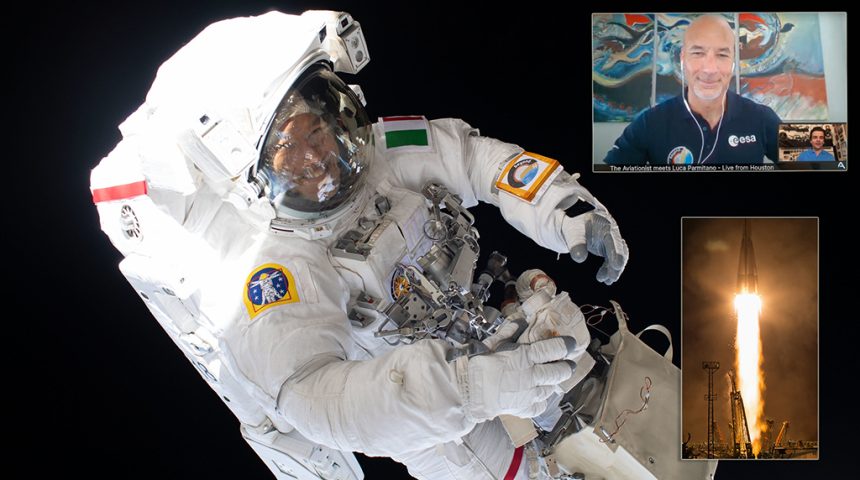Here’s what the European astronaut who’s spent the most time in orbit told us about his experiences aboard Soyuz, International Space Station, Life in Space, and how he handled two serious emergencies: one in the cockpit of a fighter jet; the other one, during his second spacewalk, when he nearly drowned in his helmet.
On July 15, 2020, this Author had a unique opportunity to interview Italian Air Force test pilot and ESA Astronaut Luca Parmitano, who joined a Facebook Live Talk Show from Houston, Texas.
Luca is not “just” an Astronaut: an Italian Air Force pilot qualified on over 20 types of military planes and helicopters, with experience aboard over 40 different types of aircraft, he has been the first Italian and third European to command the International Space Station (ISS). At 43, he’s already completed two space missions, six “spacewalks” for a total of 33 hours and 9 minutes and, above all, he has logged 366 days in space, more than any ESA astronaut in history.
My Live chat with him was simulcasted on The Aviationist Facebook page, the Italian Air Force’s official FB page and Youtube account. You can still find the recording of the Live on both FB and Youtube.
However, considered we had a limited slot (just 45 minutes) I interviewed him in Italian language only as there would have not been enough time to accommodate all the questions (including a few coming from the huge audience) and answers, and translate them all in English too. But in this article you can find a transcript of the Q&A part of the interview, with tons of interesting details.
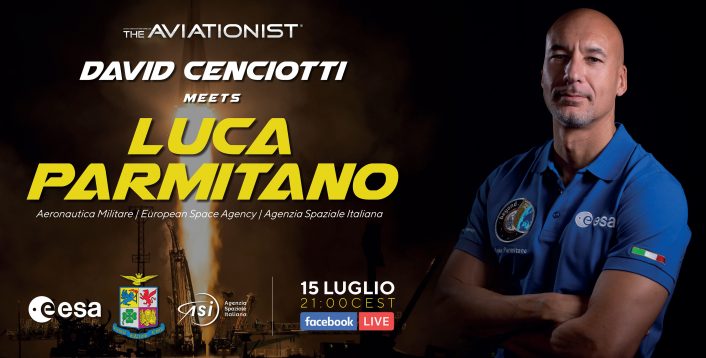
Q1: You have returned from a long-duration mission in early February. We have more or less an idea of what an astronaut does when he is in orbit, but what happens next? The experiments astronauts do in orbit do not end once you are back to earth, there is rehabilitation to do, etc. What are you doing now?
A: After returning from a long-duration mission, we start the so-called “Post Flight” phase, whose duration is the same as the time spent in orbit. The work we do in orbit does not finish with the return: as soon as we are back on Earth, the BCD (baseline data collection) activity starts. If you have had the opportunity to watch the extraction of the astronauts from the Soyuz spacecraft you will have probably noticed that, immediately after the brief ceremony arranged on site, the astronauts are put on little armchairs and surrounded by many people: there begins the first phase of data collection, with doctors measuring our pressure and temperature and assess our initial state.
Thereafter, we are moved to a tent where we start a whole series of experiments and tests that undertaken to compare the changes occurred during the mission. From there, for the subsequent six months up to 1 year after landing we are regularly checked: there are scheduled checks during the first month, then at 45 days since the return, then 60, 180. The checks are aimed at completing the physiology experiments that we started before the launch. For instance, next week I’ll end a series of tests to complete my 6-month checks.
My boss, Frank De Winne, an astronaut himself and the first ESA commander of the ISS, has already assigned me a working position for the next years. Hence, I’ve already picked up a desk, the one of the Head of the ESA Astronaut Operations Office so I’m following very closely all the activities of the astronauts in training and trying to understand in what way my office and staff can support astronauts who are preparing for the next missions. Meanwhile, I’ve also re-qualified as CapCom. The CapCom is the person in the Control Room of the Command and Control Center who’s in contact with the other astronauts in orbit. Astronauts are the perfect fit for the role because they have already spent time in the ISS, but we are too few. For this reason, engineers are also qualified for the CapCom role. I like it because it is a way to stay close to the space operations, therefore, as soon as possible, I got qualified again and I also qualified for the trainer role for robotic and EVA activities. Last week I would have had to take part in an underwater simulated EVA to replace the batteries on the ISS (an activity that is being carried out these days) but the activity was cancelled.
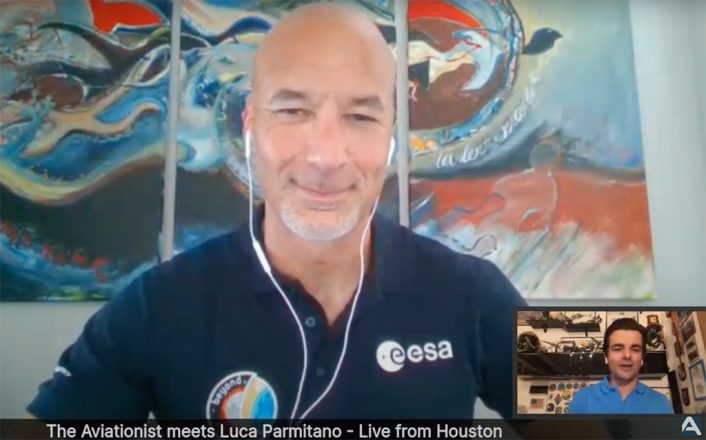
Q2: How did the experience during the “Volare” mission [in 2013] help you during the most recent mission, dubbed “Beyond”? Were the Lessons Learned of the first mission, useful?
A: Yes. Absolutely. The knowledge you grow during the mission is not only helpful during the post-flight phase; it gives you the complete awareness of what to expect both in orbit and when you return. Between the first and the second mission, I’ve prepared myself in a slightly different way because I knew which would be the effects of such preparation. For instance, during the first mission, I meticulously followed the training schedule that, from the cardiovascular point of view, required me to carry out a 25-30 minute daily workout on our treadmill or exercise bike. However, when I returned from the first mission, I found myself in perfect shape from a musculoskeletal point of view but not so well from the cardio point of view (resistance, stamina, speed). With this in mind, during the second mission, while aboard the ISS, I trained much more in the cardio part so as to be able to take part in a half-marathon within one month of my return.
Q3: How have you become an astronaut and, generally speaking, what are the requirements to become an astronaut?
A: My experience as an astronaut was born thanks to the Aeronautica Militare. When I entered in the Air Force in 1995, my project was to become a pilot of tactical aircraft. After completing my training at the Euro-NATO Joint Jet Pilot training school, at Sheppard Air Force Base, Texas, I’ve returned to Italy, to be a combat pilot. Then, I was selected to become an experimental pilot and I graduated at the EPNER, the French test pilot school, in Istres. In 2008, with the experimental pilot qualification, I could apply for a position as an ESA astronaut. There were (and there still are) two paths to become astronaut: pilot track, for those who have pilot experience, and a non-pilot track for those who have a Scientific (Engineering, Physics, Medical, etc) background. If you are in the pilot track, being a test pilot gives you more points in the selection because there is much similarity between the pilot’s work and that of astronaut. When I applied, back in 2008, two astronauts were selected from the pilot track and four (actually five, including a spare who was later called) who came from the non-pilot track.
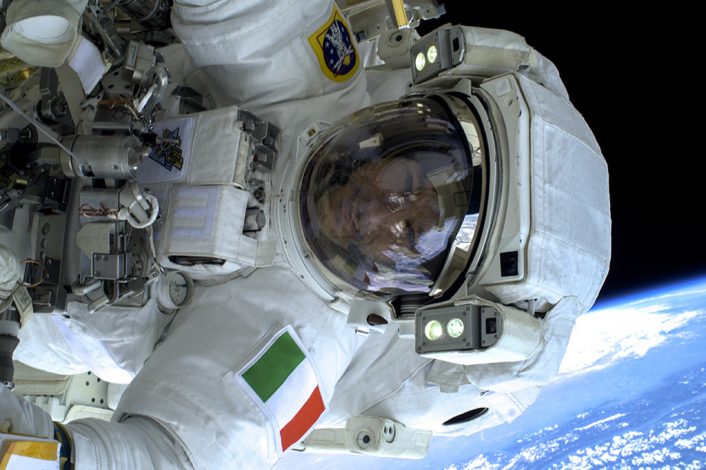
ESA astronaut Luca Parmitano during a spacewalk with NASA astronaut Chris Cassidy on Jul. 9, 2013. The spacewalk lasted 6 hours 7 minutes outside the International Space Station. (Image credit: ESA/NASA)
Q4: Regarding space flight and in particular life in space, I always wondered how a pilot accustomed to the restricted and somehow “claustrophobic” cockpit adapts to living inside the ISS, where there is much more space, you are free from gravitational effects and you have to deal with “expanded” spaces.
A: These are two completely different conditions. A pilot, when inside the cockpit, does not feel a sense of “constraint”; I’ve never felt myself “inside a cockpit”, I’ve always felt myself as “an operator in a system”, there is no claustrophobic feeling in piloting an aircraft. The feeling of “constraint” may be experienced during the launch phase inside a spacecraft as a Soyuz, because we don’t have an open cockpit, with windows, so we don’t see outside: it’s there that you may experience the feeling of being inside a submarine or in a can. However, who does this job, does not have problems in operating in tight spaces.
A certain sense of closure is given by the helmet and spacesuit, especially those used for the EVA, because you are completely closed in a vehicle (the suit and helmet are a vehicle). When aboard the ISS, the main difference is the feeling of microgravity or lack of gravity. That makes all the difference and it is the most exciting part of the mission. There is an initial phase of adaptation that is easily overcome, and quite short, compared to the duration of the whole mission.
Q5: The EVAs (Extra-Vehicular Activities) are one of the most interesting things of the mission. Is there a specific psychological preparation to an EVA?
A: No. There is no specific psychological preparation. Both NASA and ESA have specialized psychologists who work with aerospace doctors to provide support, if needed, to the astronauts. However, one of the “funnel” processes, the one that eliminates a large part of the candidates is the psychological selection. So, those who take part in such missions have a certain psychological and operational stability, and a certain approach to life. They can be leaders and wingmen at the same time, they can manage pressure and emergencies. This is the reason why many astronauts come from the military: they have already been selected to become combat pilots. At the same time, when you spend so many hundred hours in preparing an EVA operating in full suit underwater or when you take part in microgravity or Virtual Reality simulations, you are already undertaking that psychological training, as you are creating expectations on the capabilities of the systems, on what your performance will be. In fact, all training has a psychological aspect.
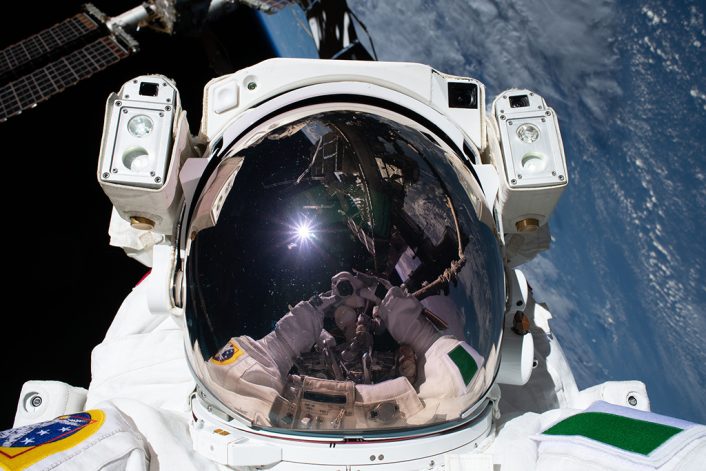
Q6: As any other pilot, you have experienced several emergencies during your career. However, there are two that have been particularly significant and famous. The first occurred when you were flying an AMX jet, the second, during your second spacewalk. Can you recall both of them and can you tell me whether, in both cases, you have followed the key principle taught to all pilots regarding how to deal with emergencies: “aviate, navigate, communicate”? Being a combat pilot has helped you managing the emergency outside the ISS during your EVA?
A: I start from the second part of the question: the answer is YES (in caps lock!). My approach in dealing with all emergencies is strictly tied to my aviation background and it’s always the same regardless of whether I’m flying or facing the everyday contingencies. The three famous words are “Aviate, Navigate, Communicate”, that can be translated in several different ways. “Aviate” means maintaining the control of your aircraft, or vehicle, or your suit, or body, etc: you have to focus on what is essential to do in that specific moment and arrange an immediate action plan. “Navigate” means that you have to chose a path: once you have the control, you can think on where you are going. This applies to an emergency as well as to the everyday life: I have control of the situation, where do I want to go next? Finally, “Communicate”: communicating is important but only when we have a clear plan in mind. At that point we can ask for support. During an emergency it is important to have situational awareness and ask for help, if possible.
During my first emergency, about 15 years ago, in 2005, over the English Channel, I experienced a birdstrike flying at low level and high speed in an AMX during the TLP (Tactical Leadership Program). A bird [stork] completely destroyed the canopy and part of the cockpit, including the HUD (Head Up Display), damaged the flight helmet, covered me of bird feathers. I lost communication, I hadn’t navigation instruments. So, I immediately climbed from 100 feet above the sea (the first step, “Aviate”) and then I did an assessment of the situation: the aircraft is flying, where do I want to go next? “Navigate”: I turned towards the coast, as I knew that was the only direction where I could find an airport to land the aircraft. Third step, “Communicate”: I radioed all the other aircraft taking part in the exercise (there were dozens involved in the mission) that I had suffered a birdstrike and, from that moment, my wingman would manage the radio communications so that I talked to him only and he relayed my messages to the rest of the flights.
Then, I started it all over again. “Aviate”: what’s the status of the aircraft? Is the engine working? Can I still fly? “Navigate”: I know that I can fly, the engine is running, where do I go? The canopy was open and the depressurization had blown away all the navigation charts, therefore the easiest way to return home was an instrument of the old AMX of the third lot [the AMX has now been upgraded to the ACOL variant], the “GO TO”, a button that, once pushed, would give you the direction to go straight to the point of origin of your flight. I decided to return to departure airfield for a series of reasons: first, because I hadn’t forward visibility and I hadn’t any nav chart in the cockpit so I couldn’t attempt to land at an alternate airport. Second, I decided to return to the departure airbase [Florennes, Belgium, where the TLP was headquartered until it was moved to Albacete, Spain] because, after one month flying from there, I perfectly knew the procedures, the airport and also knew the weather conditions were good. Thirty minutes later I was about to land and I started the process again. How do I land it? What’s the easiest way? Can I see the runway? etc
When I arrived overhead, all the other aircraft had already landed. I instructed my wingman to land, then it was my turn. The only important thing was to land without causing additional damages. Fortunately, back then I had already logged 500 flight hours on the AMX and that was the peak of experience for a Captain (as I flew all the days), so with some skill and a bit of luck, using the peripheral vision I was able to safely land [for the way he managed the emergency, Parmitano was awarded a Silver Medal to the Aeronautical Valour by the President of the Italian Republic in 2007].
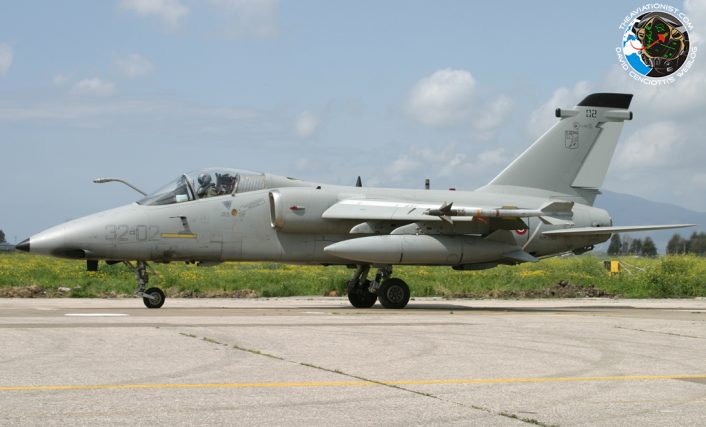
The emergency I experienced during the EVA was a bit more complex and dangerous because, as a matter of fact, it was my second extra-vehicular activity and I had little experience (besides the underwater simulations) in spacewalks. What happened is that my helmet had an unforeseen failure: along with my inexperience there was the inexperience of the rest of the world. It was an emergency that, back then, could not be faced with a check list and list of actions (that we have today). My helmet started to fill with water because of a failure of the cooling system. Instead of pumping water into the cooling system, a pump started pumping water into the ventilation system. Because of the weightlessness, about 1.5 l of water started to fill my helmet. 1.5 liters of water may seem not too much, but the helmet is very small and it fills very fast. So, once I assessed that the emergency was real and there could have been consequences, the Command and Control Center directed me back to the sealed chamber in the ISS, unfortunately separating me from my EVA partner because our emergency cables had an opposite path to the one I had to go to return aboard. So, I came back alone, but at that moment, with the sun setting, the water covered my eyes, nose and ears, isolating me: I was outside of the ISS without the possibility to see and hear. Fortunately the water covered only my nose, allowing me to breathe with my mouth although I couldn’t communicate with anyone.
Once again: “Aviate, Navigate, Communicate”.
“Aviate”: don’t panic. Keep control of the helmet and your body. “Navigate”: try to understand how to get back into the ISS in the shortest time possible, in the blind, using only available tools: my touch, my knowledge of the station, trying to recognize the handles that allow us to move around the ISS. “Communicate”: as far as I was concerned, I did not know if the Command and Control Center was receiving my messages so I continued to talk during the whole phase of return to the Station providing updates about the emergency situation. Unfortunately, they were not receiving me; they got my messages when I was back in the Station, after about 7 minutes from the beginning of the most serious phase of the emergency, the one in the darkness. Fortunately, I’m here to tell you the story, so everything went well.
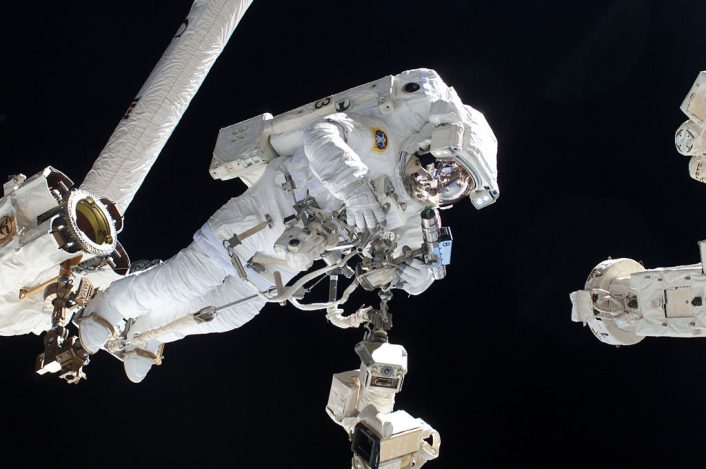
Let me conclude by saying that it was a very interesting experience, both from the astronautical and from the personal point of view, especially for what happened next, for all the actions that were put in place, to eliminate the possibility that the same emergency could happen again in the future. So, the procedures were changed, the helmet pumps that could be subject to the same type of problem were changed. In the end, today we know that this type of emergency cannot be repeated: from now on it will no longer be an emergency, but a contingency.
Q7: The EVA emergency has provided a series of Lessons Learned. It’s interesting to notice how the astronaut becomes himself a test subject: your characteristics, your physiological parameters are constantly monitored. In other words, an astronaut is both an explorer and researcher, but also a “guinea pig”.
A: Indeed. We cannot deny that the physiological studies are perhaps among the most important. In orbit we can study the neurological apparatus, the vestibular apparatus, the musculoskeletal apparatus, the cardiovascular apparatus in unique conditions. Moreover, it is also important to understand how physiology in space works as this will allow us to do very long-term exploration, well beyond the lower Earth orbit.
Q8: In other interviews, you’ve said that you are interested in the Lunar Exploration. What can you tell us about the future of space exploration with Crew Dragon and what about the future of Astronaut Luca Parmitano?
A: Dealing with the Commercial Crew Vehicles, like Dragon, Starliner and others, this is a moment of great evolution and like every moment of evolution there is an initial settlement because these spacecrafts must be experimented to understand their capabilities and the way they will be operated. I am following these programs very closely from a support point of view because have a very thorough knowledge of the systems is required to give support. Therefore, I’m studying to get to the level of knowledge I had about Soyuz. They are very interesting, extremely different machines, an evolution of the Soyuz which is a product of 50 years ago, especially when it deals with the integration of the astronaut with the spacecraft. Certainly I’m very attracted by the Artemis missions and lunar exploration because ESA together with ASI [Agenzia Spaziale Italiana – Italian Space Agency] are extremely interested in lunar exploration. We are already participating in the program in a primary way: for what concerns the habitat that will be created in the orbit around the moon, we are “in the driver’s seat”. So our goal as space agencies and astronauts is to be leader in lunar exploration and to bring European astronauts to the moon. I am not even 44 years old but I have already taken part in 2 space missions: I think and hope I can make a valid contribution to these programs, both from an operational and a leadership point of view. I hope that the agencies that will select the astronauts participating in these missions in the future will consider me as one of the candidates. I will be ready: this is the job and dream of any astronaut.
Good Luck Luca!
Here below you can watch the full interview (in Italian):
The Author wishes to thank the Italian Air Force, the Agenzia Spaziale Italiana and the European Space Agency for the support provided in preparing the interview. Needless to say, a special thank you goes to Luca Parmitano that you can follow online on Twitter, Facebook and Instagram.

